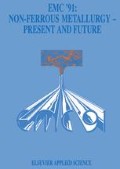Resume
Les types de fours tournants utilisés pour le recyclage des métaux non-ferreux, sont le plus souvent des fours à tambour avec garnissage basique. L’analyse des échanges de chaleur explique pourquoi le rendement thermique des fours tournants est supérieur à celui des fours à reverbère. La prédominance des fours tournants, par ex. pour le recyclage du plomb, du cuivre ou de l’aluminium, restera assurée pour de nombreuses années encore, en particulier grâce à l’utilisation de brûleurs avec air de combustion enrichi et/ou préchauffé ou bien de brûleurs à oxygène.
Abstract
The type of rotary furnace currently most employed in the recycling of non-ferrous metals consists of furnaces lined with basic refractories. The analysis of heat transfer explains why the thermal efficiency of rotary furnaces is higher than those of reverberatory furnaces. The rotary furnaces will continue to predominate, e.g. for lead, copper or aluminium recycling, for many years to come especially with regard to the utilization of burners with oxygen-enriched air and/or preheated air or even with oxy-fuel burners.
Access this chapter
Tax calculation will be finalised at checkout
Purchases are for personal use only
Preview
Unable to display preview. Download preview PDF.
Littérature
Rousseau M., Lead Scrap Processing in Rotary Furnaces: A Review, 5th Int. Recycling Congress (IRC), Berlin, 1986, pp 1721–1727
Melin A., M. Rousseau, Recyclage du plomb: Les techniques industrielles actuelles. Acta Tecnica Belgica, ATB-Metallurgie, Vol. XXII No. 4, pp 229–235
Rousseau M., K. Boeger, Recovery of Zinc and Aluminium from Secondaries by Sweating. TMS/AIME (Etats-Unis), Technical Paper A 88–7
Jaeck M.L., Primary and Secondary Lead Processing. Proc. Int. Symp. CIM, 28th An. Conf., Trail, Canada, Aug. 1989, pp 106
Barr P.V., J.K. Brimacombe, A.P. Watkinson, Heat-transfer Model for the Rotary Kiln with Pilot Plant Verification. Pyrometallurgy’87, IMM (London), Sept 1987, pp 53–90
Gorog J.P., T.N. Adams, J.K. Brimacombe, Regenerative Heat Transfer in Rotary Kilns. Met. Trans. 8, Vol. 13 B, June 1982, pp 153–163
Knauber K., Moderne Erdgas-befeuerte Industriebrenner. G.W.I.. Bd. 36, 1987, H. 4, pp 226–229
Gorog J.P., J.K. Brimacombe, T.N. Adams, Radiative Heat Transfer in Rotary Kilns. Met. Trans. 8, Vol 12 B, March 1981, pp 55–70
Fritsch W.H., Technisch-wirtschaftliche Auslegung von Industrie-Brennern. G.W.I., Bd. 32, 1983, H.5, pp 194–201
Lamm K.F., Use of oxy-fuel burners. Productivity and Technology in the Metallurgical industries, TMS/GDMB, 1989, pp 473–481
Hanzlik K.. Wie sinnvoll ist O 2 -Anreicherung?. G.W.I., Bd. 34, 1985, H. 9, pp 370–374
Granitzky, K-E, Auswahl des Feuerfesten Baustoffes. 1 Met. Sem. der G.D.M.B., 1975, pp 143–168
Rousseau M., K. Boeger, Processing of Complex NF-Secondaries in Rotary Furnaces: A Review. 5th Recycling Congress (IRC), Berlin, 1986, pp 1721–1727
Deininger L., G. Fuchs, Neue Dreflammofenanlage. Erzmetall, 33, Nr. 5, 1983, pp 226–229
Deininger L., Einsatz von Sauerstoffbrennern. GDMB-Bleifachausschuß 1984.10 pages
Ann., Kupferverarbeitung der Norddeutschen Affinerie, Erzmetall 39, 1986, Nr. 10, pp 518–519
Lombeck K., Neuere Entwicklungen beim Schmelzen von Cu-Schrotten, Int. Recycling Symp. der Metallgesellschaft AG, Nov. 1986, Budapest, 18 pages
Schlug K., Das neue Al-Umschmelzwerk Ronshofen. Metall, H. 11, Nov. 1980, pp 1052–1053
Jasper H.D., Moderne Feuerungstechnik für Öfen. 3. Jahrestagung der VDI-GEI, Darmstadt, Febr. 1986, 19 pages
Bücker W., Sauerstoff zur Steigerung der Schmelzleistung bei Aluminium. O2-Anwendung in der Pyrometallurgie, 10. Met. Sem. G.D.M.B., 1980
Rousseau M., A. Melin, The Processing of Non-Magnetic Fractions from Shredded Automobile Scrap; A Review. Ressources Conversation and Recycling, 2, 1989, pp 139–159
Barett K.R., Lead Smelting Technologies into the 90’s. ILZIC Conf., New Delhi, Nov. 88, pp 25.1–25.11
Anon., Billitons’s New Arnheim Furnace. Metal Bulletin, 26.02.1990
Hartley C.J., Zinnrecycling mit dem Sirosmelt-Verfahren, Metall, H.9, Sept. 1990, 873–875
Author information
Authors and Affiliations
Rights and permissions
Copyright information
© 1991 Institution of Mining and Metallurgy
About this chapter
Cite this chapter
Rousseau, M. (1991). Les fours tournants dans l’industrie européenne de la récupération des métaux non-ferreux. In: EMC ’91: Non-Ferrous Metallurgy—Present and Future. Springer, Dordrecht. https://doi.org/10.1007/978-94-011-3684-6_29
Download citation
DOI: https://doi.org/10.1007/978-94-011-3684-6_29
Publisher Name: Springer, Dordrecht
Print ISBN: 978-1-85166-715-4
Online ISBN: 978-94-011-3684-6
eBook Packages: Springer Book Archive

